Spatiotemporal Land Use and Land Cover Changes and Associated Runoff Impact in Itaperuna, Brazil
Abstract
:1. Introduction
2. Materials and Methods
2.1. Study Area
2.2. Data Sources and Methodology
2.2.1. Land Use and Land Cover (LULC) Maps
2.2.2. Soil Types and Hydrological Classification
2.2.3. Precipitation Data and Digital Elevation Model
2.3. Urban Flood Risk Mitigation InVEST
3. Results
3.1. Land Use and Land Cover (LULC)
3.2. LULC and Its Impact on Surface Runoff
4. Discussion
5. Conclusions
Author Contributions
Funding
Data Availability Statement
Acknowledgments
Conflicts of Interest
References
- United Nations. Handbook of Statistics; United Nations: Geneva, Switzerland, 2018. [Google Scholar]
- Chen, D.; Hu, W.; Li, Y.; Zhang, C.; Lu, X.; Cheng, H. Exploring the temporal and spatial effects of city size on regional economic integration: Evidence from the Yangtze River Economic Belt in China. Land Use Policy 2023, 132, 106770. [Google Scholar] [CrossRef]
- Arnone, E.; Pumo, D.; Francipane, A.; La Loggia, G.; Noto, L.V. The Role of Urban Growth, Climate Change, and Their Interplay in Altering Runoff Extremes. Hydrol. Process. 2018, 32, 1755–1770. [Google Scholar] [CrossRef]
- Borges, E.C.; Paz, I.; Leite, N.A.D.; Willinger, B.; Ichiba, A.; Gires, A.; de Campos, P.C.O.; Monier, L.; Cardinal, H.; Amorim, J.C.C.; et al. Evaluation of the Spatial Variability of Ecosystem Services and Natural Capital: The Urban Land Cover Change Impacts on Carbon Stocks. Int. J. Sustain. Dev. World Ecol. 2020, 28, 339–349. [Google Scholar] [CrossRef]
- Paz, I.; Willinger, B.; Gires, A.; de Souza, B.A.; Monier, L.; Cardinal, H.; Tisserand, B.; Tchiguirinskaia, I.; Schertzer, D. Small-Scale Rainfall Variability Impacts Analyzed by Fully-Distributed Model Using C-Band and X-Band Radar Data. Water 2019, 11, 1273. [Google Scholar] [CrossRef]
- Campos, P.C.O.; Paz, T.S.R.; Lenz, L.; Qiu, Y.; Alves, C.N.; Simoni, A.P.R.; Amorim, J.C.C.; Lima, G.B.A.; Rangel, M.P.; Paz, I. Multi-Criteria Decision Method for Sustainable Watercourse Management in Urban Areas. Sustainability 2020, 12, 6493. [Google Scholar] [CrossRef]
- Seto, K.C.; Fragkias, M.; Güneralp, B.; Reilly, M.K. A Meta-Analysis of Global Urban Land Expansion. PLoS ONE 2011, 6, e23777. [Google Scholar] [CrossRef] [PubMed]
- Zeleňáková, M.; Vranayová, Z.; Repel, A.; Kaposztasová, D. Surface Runoff in Urban Area—Case Study. In New Trends in Urban. Drainage Modelling. UDM 2018. Green. Energy and Technology; Mannina, G., Ed.; Springer: Cham, Switzerland, 2019. [Google Scholar] [CrossRef]
- Jacobson, C.R. Identification and Quantification of the Hydrological Impacts of Imperviousness in Urban Catchments: A Review. J. Env. Manag. 2011, 92, 1438–1448. [Google Scholar] [CrossRef]
- Hao, L.; Sun, G.; Liu, Y.; Wan, J.; Qin, M.; Qian, H.; Liu, C.; Zheng, J.; John, R.; Fan, P.; et al. Urbanization Dramatically Altered the Water Balances of a Paddy Field-Dominated Basin in Southern China. Hydrol. Earth Syst. Sci. 2015, 19, 3319–3331. [Google Scholar] [CrossRef]
- Feng, B.; Zhang, Y.; Bourke, R. Urbanization Impacts on Flood Risks Based on Urban Growth Data and Coupled Flood Models. Nat. Hazards 2021, 106, 613–627. [Google Scholar] [CrossRef]
- Thanapura, P.; Helder, D.L.; Burckhard, S.; Warmath, E.; O’Neill, M.; Galster, D. Mapping Urban Land Cover Using QuickBird NDVI and GIS Spatial Modeling for Runoff Coefficient Determination. Photogramm. Eng. Remote Sens. 2007, 73, 57–65. [Google Scholar] [CrossRef]
- Chapman, S.; Watson, J.E.M.; Salazar, A.; Thatcher, M.; McAlpine, C.A. The Impact of Urbanization and Climate Change on Urban Temperatures: A Systematic Review. Landsc. Ecol. 2017, 32, 1921–1935. [Google Scholar] [CrossRef]
- Yao, L.; Wei, W.; Chen, L. How Does Imperviousness Impact the Urban Rainfall-Runoff Process under Various Storm Cases? Ecol. Indic. 2016, 60, 893–905. [Google Scholar] [CrossRef]
- Amarasinghe, M.P.; Kulathilaka, S.A.S.; Robert, D.J.; Zhou, A.; Jayathissa, H.A.G. Risk assessment and management of rainfall-induced landslides in tropical regions: A review. Nat. Hazards 2023, 1–53. [Google Scholar] [CrossRef]
- McGrane, S.J. Impacts of Urbanisation on Hydrological and Water Quality Dynamics, and Urban Water Management: A Review. Hydrol. Sci. J. 2016, 61, 2295–2311. [Google Scholar] [CrossRef]
- Li, C.; Sun, G.; Caldwell, P.V.; Cohen, E.; Fang, Y.; Zhang, Y.; Oudin, L.; Sanchez, G.M.; Meentemeyer, R.K. Impacts of Urbanization on Watershed Water Balances Across the Conterminous United States. Water Resour. Res. 2020, 56, e2019WR026574. [Google Scholar] [CrossRef]
- Oñate-Valdivieso, F.; Oñate-Paladines, A.; Collaguazo, M. Spatiotemporal Dynamics of Soil Impermeability and Its Impact on the Hydrology of An Urban Basin. Land 2022, 11, 250. [Google Scholar] [CrossRef]
- Müller, A.; Österlund, H.; Marsalek, J.; Viklander, M. The Pollution Conveyed by Urban Runoff: A Review of Sources. Sci. Total Environ. 2020, 709, 136125. [Google Scholar] [CrossRef]
- Qin, Y. Urban Flooding Mitigation Techniques: A Systematic Review and Future Studies. Water 2020, 12, 3579. [Google Scholar] [CrossRef]
- Brito, G.Q.; Murta, J.R.d.M.; Salemi, L.F. Surface Runoff from an Urban Area Promotes Hydrological Connectivity and Soil Loss in a Tropical Riparian Forest. Water Air Soil Pollut. 2022, 233, 204. [Google Scholar] [CrossRef]
- Walsh, C.J.; Fletcher, T.D.; Burns, M.J. Urban Stormwater Runoff: A New Class of Environmental Flow Problem. PLoS ONE 2012, 7, e45814. [Google Scholar] [CrossRef]
- Xu, S.; Yang, K.; Xu, Y.; Zhu, Y.; Luo, Y.; Shang, C.; Zhang, J.; Zhang, Y.; Gao, M.; Wu, C. Urban Land Surface Temperature Monitoring and Surface Thermal Runoff Pollution Evaluation Using UAV Thermal Remote Sensing Technology. Sustainability 2021, 13, 11203. [Google Scholar] [CrossRef]
- He, C.; James, L.A. Watershed Science: Linking Hydrological Science with Sustainable Management of River Basins. Sci. China Earth Sci. 2021, 64, 677–690. [Google Scholar] [CrossRef]
- Figueiredo, P.M.A.; Lippo, B.B.; de Quevedo, D.M. Importância Do Monitoramento e Disponibilização de Dados Hidrológicos Para a Gestão Integrada Dos Recursos Hídricos. Soc. Nat. 2020, 32, 308–320. [Google Scholar] [CrossRef]
- Medina, Y.; Muñoz, E.; Clasing, R.; Arumí, J.L. Analysis of the Relative Importance of the Main Hydrological Processes at Different Temporal Scales in Watersheds of South-Central Chile. Water 2022, 14, 807. [Google Scholar] [CrossRef]
- Samie, M.; Ghazavi, R.; Vali, A.; Pakparvar, M. Evaluation of the Effect of Land Use Change on Runoff Using Supervised Classified Satellite Data. Glob. Nest J. 2019, 21, 245–252. [Google Scholar] [CrossRef]
- Senbeta, T.B.; Romanowicz, R.J. The Role of Climate Change and Human Interventions in Affecting Watershed Runoff Responses. Hydrol. Process. 2021, 35, e14448. [Google Scholar] [CrossRef]
- Felix, N.B.; Campos, P.C.d.O.; Paz, I.; Marques, M.E.S. Geoprocessing Applied to the Assessment of Carbon Storage and Sequestration in a Brazilian Medium-Sized City. Sustainability 2022, 14, 8761. [Google Scholar] [CrossRef]
- Kifle, T.; Deres, A.; Birku, A.; Aberham, T.; Mengist, D. Evaluation of the Impacts of Land Use and Land Cover Changes Using Erosion Assessment Model at Tikur Wuha Watershed. Int. J. Res.-GRANTHAALAYAH 2020, 8, 75–91. [Google Scholar] [CrossRef]
- Chen, D.; Hu, W. Temporal and Spatial Effects of Heavy Metal-Contaminated Cultivated Land Treatment on Agricultural Development Resilience. Land 2023, 12, 945. [Google Scholar] [CrossRef]
- Mojaddadi, H.; Pradhan, B.; Nampak, H.; Ahmad, N.; Ghazali, A.H. bin Ensemble Machine-Learning-Based Geospatial Approach for Flood Risk Assessment Using Multi-Sensor Remote-Sensing Data and GIS. Geomat. Nat. Hazards Risk 2017, 8, 1080–1102. [Google Scholar] [CrossRef]
- Rollenbeck, R.; Orellana-Alvear, J.; Rodriguez, R.; Macalupu, S.; Nolasco, P. Calibration of X-Band Radar for Extreme Events in a Spatially Complex Precipitation Region in North Peru: Machine Learning vs. Empirical Approach. Atmosphere 2021, 12, 1561. [Google Scholar] [CrossRef]
- Silva, E.J.R.d.; Alves, C.N.; Campos, P.C.d.O.; Oliveira, R.A.A.C.e.; Marques, M.E.S.; Amorim, J.C.C.; Paz, I. Comparison of Rain Gauge Network and Weather Radar Data: Case Study in Angra dos Reis, Brazil. Water 2022, 14, 3944. [Google Scholar] [CrossRef]
- Ding, J.; Gao, J.; Zhang, G.; Zhang, F.; Yang, J.; Wang, S.; Xue, B.; Wang, K. A Rolling Real-Time Correction Method for Minute Precipitation Forecast Based on Weather Radars. Water 2023, 15, 1872. [Google Scholar] [CrossRef]
- Wang, X.; Xie, H. A Review on Applications of Remote Sensing and Geographic Information Systems (GIS) in Water Resources and Flood Risk Management. Water 2018, 10, 608. [Google Scholar] [CrossRef]
- Dogra, A.; Thakur, J.; Tandon, A. Do satellite-based products suffice for rainfall observations over data-sparse omplex terrains? Evidence from the North-Western Himalayas. Remote Sens. Environ. 2023, 299, 113855. [Google Scholar] [CrossRef]
- Lim, T.C.; Welty, C. Effects of Spatial Configuration of Imperviousness and Green Infrastructure Networks on Hydrologic Response in a Residential Sewershed. Water Resour. Res. 2017, 53, 8084–8104. [Google Scholar] [CrossRef]
- Fok, H.S.; Chen, Y.; Wang, L.; Tenzer, R.; He, Q. Improved Mekong Basin Runoff Estimate and Its Error Characteristics Using Pure Remotely Sensed Data Products. Remote Sens. 2021, 13, 996. [Google Scholar] [CrossRef]
- Kumar, A.; Agarwal, V.; Pal, L.; Chandniha, S.K.; Mishra, V. Effect of Land Surface Temperature on Urban Heat Island in Varanasi City, India. J—Multidiscip. Sci. J. 2021, 4, 420–429. [Google Scholar] [CrossRef]
- Huang, C.; Chen, T.; Yi, H.; Xu, X.; Chen, S.; Chen, W. Collaborative Environmental Governance, Inter-Agency Cooperation and Local Water Sustainability in China. Sustainability 2017, 9, 2305. [Google Scholar] [CrossRef]
- Bose, S.; Mazumdar, A. Urban Flood Risk Assessment and Mitigation with InVEST-UFRM Model: A Case Study on Kolkata City, West Bengal State (India). Arab. J. Geosci. 2023, 16, 320. [Google Scholar] [CrossRef]
- Qi, W.; Ma, C.; Xu, H.; Chen, Z.; Zhao, K.; Han, H. A Review on Applications of Urban Flood Models in Flood Mitigation Strategies. Nat. Hazards 2021, 108, 31–62. [Google Scholar] [CrossRef]
- Chen, J.; Li, Y.; Zhang, C.; Tian, Y.; Guo, Z. Urban Flooding Prediction Method Based on the Combination of LSTM Neural Network and Numerical Model. Int. J. Environ. Res. Public Health 2023, 20, 1043. [Google Scholar] [CrossRef] [PubMed]
- Albano, R.; Mancusi, L.; Sole, A.; Adamowski, J. FloodRisk: A Collaborative, Free and Open-Source Software for Flood Risk Analysis. Geomat. Nat. Hazards Risk 2017, 8, 1812–1832. [Google Scholar] [CrossRef]
- Beilicci, E.; Beilicci, R.; David, I. Hydroinformatic Tools for Flood Risk Map Achievement. Int. J. Energy 2021, 15, 27–32. [Google Scholar] [CrossRef]
- Darabi, H.; Choubin, B.; Rahmati, O.; Torabi Haghighi, A.; Pradhan, B.; Kløve, B. Urban Flood Risk Mapping Using the GARP and QUEST Models: A Comparative Study of Machine Learning Techniques. J. Hydrol. 2019, 569, 142–154. [Google Scholar] [CrossRef]
- Kadaverugu, A.; Nageshwar Rao, C.; Viswanadh, G.K. Quantification of Flood Mitigation Services by Urban Green Spaces Using InVEST Model: A Case Study of Hyderabad City, India. Model. Earth Syst. Environ. 2021, 7, 589–602. [Google Scholar] [CrossRef]
- Soulis, K.X. Soil Conservation Service Curve Number (SCS-CN) Method: Current Applications, Remaining Challenges, and Future Perspectives. Water 2021, 13, 192. [Google Scholar] [CrossRef]
- Xiao, B.; Wang, Q.-H.; Fan, J.; Han, F.-P.; Dai, Q.-H. Application of the SCS-CN Model to Runoff Estimation in a Small Watershed with High Spatial Heterogeneity. Pedosphere 2011, 21, 738–749. [Google Scholar] [CrossRef]
- Mishra, S.K.; Singh, V.P. Soil Conservation Service Curve Number (SCS-CN) Methodology; Springer: Dordrecht, The Netherlands, 2003; Volume 42, ISBN 978-90-481-6225-3. [Google Scholar]
- Hu, S.; Fan, Y.; Zhang, T. Assessing the Effect of Land Use Change on Surface Runoff in a Rapidly Urbanized City: A Case Study of the Central Area of Beijing. Land 2020, 9, 17. [Google Scholar] [CrossRef]
- Vojtek, M.; Vojteková, J. Land Use Change and Its Impact on Surface Runoff from Small Basins: A Case of Radiša Basin. Folia Geogr. 2019, 60, 104–125. [Google Scholar]
- Ozdemir, H.; Elbaşı, E. Benchmarking Land Use Change Impacts on Direct Runoff in Ungauged Urban Watersheds. Phys. Chem. Earth Parts A/B/C 2015, 79, 100–107. [Google Scholar] [CrossRef]
- Jahan, K.; Pradhanang, S.M.; Bhuiyan, M.A.E. Surface Runoff Responses to Suburban Growth: An Integration of Remote Sensing, GIS, and Curve Number. Land 2021, 10, 452. [Google Scholar] [CrossRef]
- Chatterjee, C.; Jha, R.; Lohani, A.K.; Kumar, R.; Singh, R. Runoff Curve Number Estimation for a Basin Using Remote Sensing and GIS. Asian-Pac. Remote Sens. GIS J. 2001, 14, 1–8. [Google Scholar]
- NRCS. Urban Hydrology for Small Watersheds TR-55; NRCS: Washington, DC, USA, 1986.
- Al-Juaidi, A.E.M. A Simplified GIS-Based SCS-CN Method for the Assessment of Land-Use Change on Runoff. Arab. J. Geosci. 2018, 11, 269. [Google Scholar] [CrossRef]
- IBGE—Instituto Brasileiro de Geografia e Estatística. Panorama IBGE Itaperuna-RJ. Available online: https://cidades.ibge.gov.br/brasil/rj/itaperuna/panorama (accessed on 14 August 2023).
- IBGE—Instituto Brasileiro de Geografia e Estatística. Censo. 2010. Available online: https://censo2010.ibge.gov.br (accessed on 16 December 2023).
- Martorano, L.G.; Rossiello, R.O.P.; Meneguelli, N.A.; Lumbreras, J.F.; Valle, L.S.S.; Motta, P.E.F.; Rebello, E.R.G.; Said, U.P.; Martins, G.S. Aspectos Climáticos do Noroeste Fluminense, RJ.—Portal Embrapa; Embrapa Solos: Rio de Janeiro, Brazil, 2003. [Google Scholar]
- Santos, H.d.; Jacomine, P.; Anjos, L.d.; Oliveira, V.; Lumbreras, J.; Coelho, M.; Almeida, J.; Filho, J.; Oliveira, J.d.; Cunha, T. Sistema Brasileiro de Classificação dos Solos; Embrapa Solos: Rio de Janeiro, Brazil, 2018. [Google Scholar]
- Salviano, M.; Matos, A. Relatório Anual Do Sistema de Alerta Hidrológico Da Bacia Do Rio Muriaé—2023; Serviço Geológico do Brasil-CPRM: São Paulo, Brazil, 2023. [Google Scholar]
- Fundação COPPETEC. Plano de Recursos Hídricos da Bacia do Rio Paraíba do Sul—Resumo; Resende, R.J., Ed.; Fundação COPPETEC: Rio de Janeiro, Brazil, 2006. [Google Scholar]
- Paz, T.S.R.; Rocha, V.G., Jr.; Campos, P.C.O.; Paz, I.; Caiado, R.G.G.; Rocha, A.A.; Lima, G.B.A. Hybrid Method to Guide Sustainable Initiatives in Higher Education: A Critical Analysis of Brazilian Municipalities. Int. J. Sustain. High. Educ. 2022, 24, 299–316. [Google Scholar] [CrossRef]
- Diniz, D. O desenvolver de um município: Itaperuna. In Do Germinar à Frutificação; Damadá Artes Gráficas e Editora: Rio de Janeiro, Brazil, 1985. [Google Scholar]
- Costa, J.; Hora, A. A Dinâmica Dos Processos Relacionados Às Inundações No Município de Itaperuna-RJ. Sodebras 2016, 11, 129. [Google Scholar]
- Campos, P.C.d.O.; Paz, I. Spatial Diagnosis of Rain Gauges’ Distribution and Flood Impacts: Case Study in Itaperuna, Rio de Janeiro—Brazil. Water 2020, 12, 1120. [Google Scholar] [CrossRef]
- INPE—Instituto Nacional de Pesquisas Espaciais. Cbers-3 e 4. Available online: http://www.cbers.inpe.br/sobre/cbers3-4.php (accessed on 15 August 2023).
- QGIS 3.22.8. Available online: https://qgis.org (accessed on 28 June 2023).
- IBGE—Instituto Brasileiro de Geografia e Estatística. Mapa de Vegetação do Brasil. Available online: https://geoftp.ibge.gov.br/informacoes_ambientais/vegetacao/mapas/brasil/vegetacao.pdf (accessed on 17 December 2023).
- Genovez, A.; Neto, F.; Sartori, A. Classificação Hidrológica de Solos Brasileiros Para a Estimativa Da Chuva Excedente Com o Método Do Serviço de Conservação Do Solo Dos Estados Unidos Parte 1: Classificação. Rev. Bras. Recur. Hídri. 2005, 10, 5–18. [Google Scholar] [CrossRef]
- ANA—Agência Nacional de Águas e Saneamento Básico. Nota Técnica nº 46/2018/SPR. Produção de Base Vetorial com o Curve Number (CN) para BHO 2014 (BHO_CN). Available online: https://metadados.snirh.gov.br/geonetwork/srv/api/records/d1c36d85-a9d5-4f6a-85f7-71c2dc801a67/attachments/NOTA_TECNICA_46_2018_SPR.pdf (accessed on 10 August 2023).
- ANA—Agência Nacional de Águas e Saneamento Básico. HidroWeb Mobile. Available online: https://www.snirh.gov.br/hidroweb-mobile/mapa (accessed on 14 August 2023).
- INMET—Instituto Nacional de Meteorologia. BDMEP. Banco de dados Meteorológicos do INMET. Available online: https://bdmep.inmet.gov.br (accessed on 17 September 2023).
- INPE—Instituto Nacional de Pesquisas Espaciais. TOPODATA. Banco de Dados Geomorfométricos do Brasil. Available online: http://www.dsr.inpe.br/topodata/ (accessed on 3 October 2023).
- Tucci, C.E.M. Escoamento superficial. In Tucci, C.E.M. (org.). Hidrologia: Ciência e Aplicação, 3rd ed.; ABRH/UFRGS: Porto Alegre, Brazil, 2004; pp. 391–441. [Google Scholar]
- Damtea, W.; Kim, D.; Im, S. Spatiotemporal Analysis of Land Cover Changes in the Chemoga Basin, Ethiopia, Using Landsat and Google Earth Images. Sustainability 2020, 12, 3607. [Google Scholar] [CrossRef]
- Solórzano, J.V.; Mas, J.F.; Gao, Y.; Gallardo-Cruz, J.A. Land Use Land Cover Classification with U-Net: Advantages of Combining Sentinel-1 and Sentinel-2 Imagery. Remote Sens. 2021, 13, 3600. [Google Scholar] [CrossRef]
- Hernandez, M.; Miller, S.N.; Goodrich, D.C.; Goff, B.F.; Kepner, W.G.; Edmonds, C.M.; Jones, K.B. Modeling Runoff Response to Land Cover and Rainfall Spatial Variability in Semi-Arid Watersheds. Environ. Monit. Assess. 2000, 64, 285–298. [Google Scholar] [CrossRef]
- Fohrer, N.; Haverkamp, S.; Eckhardt, K.; Frede, H.-G. Hydrologic Response to Land Use Changes on the Catchment Scale. Phys. Chem. Earth Part B Hydrol. Ocean. Atmos. 2001, 26, 577–582. [Google Scholar] [CrossRef]
- Zhang, Y.; Xia, J.; Yu, J.; Randall, M.; Zhang, Y.; Zhao, T.; Pan, X.; Zhai, X.; Shao, Q. Simulation and As-sessment of Urbanization Impacts on Runoff Metrics: Insights from Landuse Changes. J. Hydrol. 2018, 560, 247–258. [Google Scholar] [CrossRef]
- Sajikumar, N.; Remya, R.S. Impact of Land Cover and Land Use Change on Runoff Characteristics. J. Env. Manag. 2015, 161, 460–468. [Google Scholar] [CrossRef]
- Marhaento, H.; Booij, M.J.; Rientjes, T.H.M.; Hoekstra, A.Y. Attribution of Changes in the Water Balance of a Tropical Catchment to Land Use Change Using the SWAT Model. Hydrol. Process. 2017, 31, 2029–2040. [Google Scholar] [CrossRef]
- Astuti, I.S.; Sahoo, K.; Milewski, A.; Mishra, D.R. Impact of Land Use Land Cover (LULC) Change on Sur-face Runoff in an Increasingly Urbanized Tropical Watershed. Water Resour. Manag. 2019, 33, 4087–4103. [Google Scholar] [CrossRef]
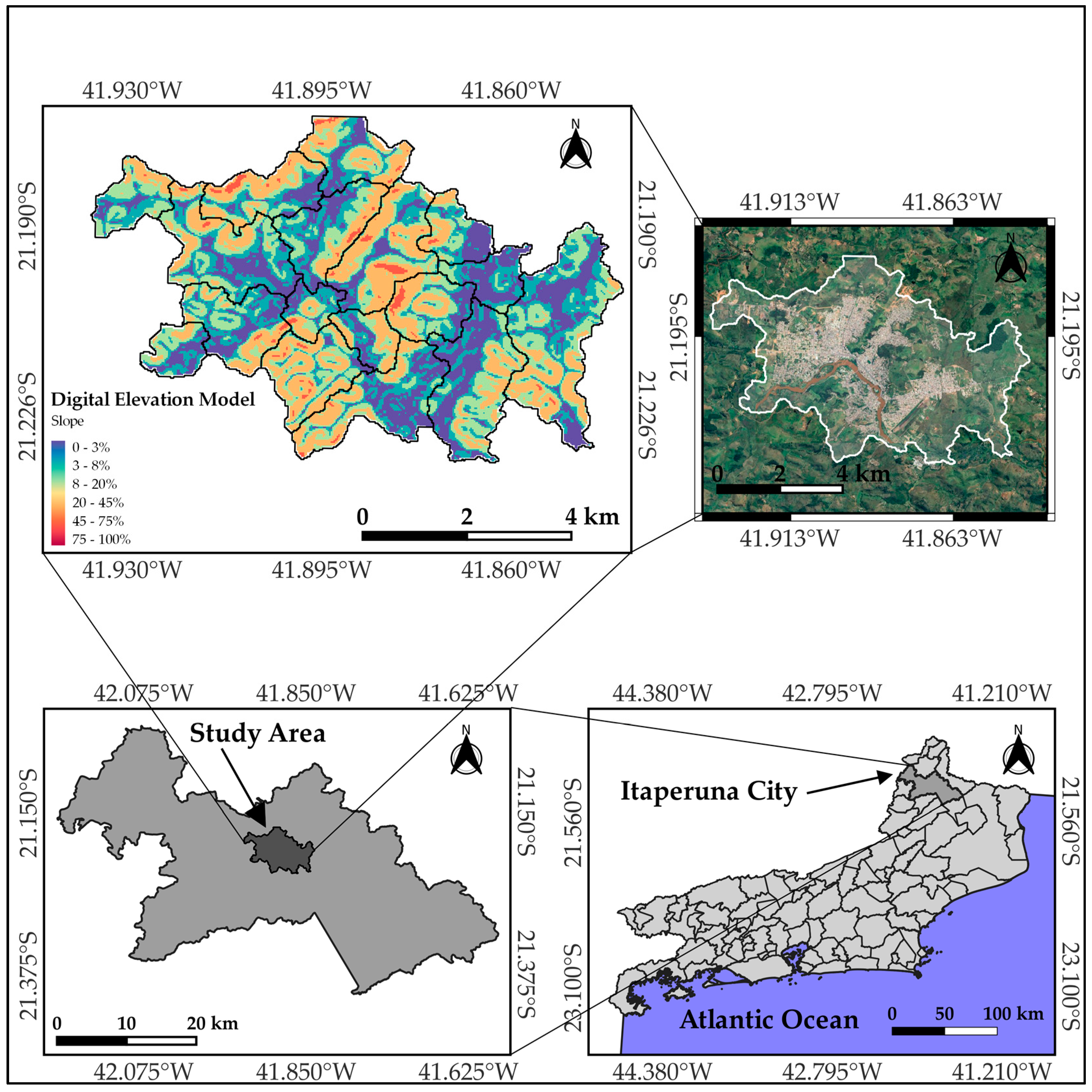
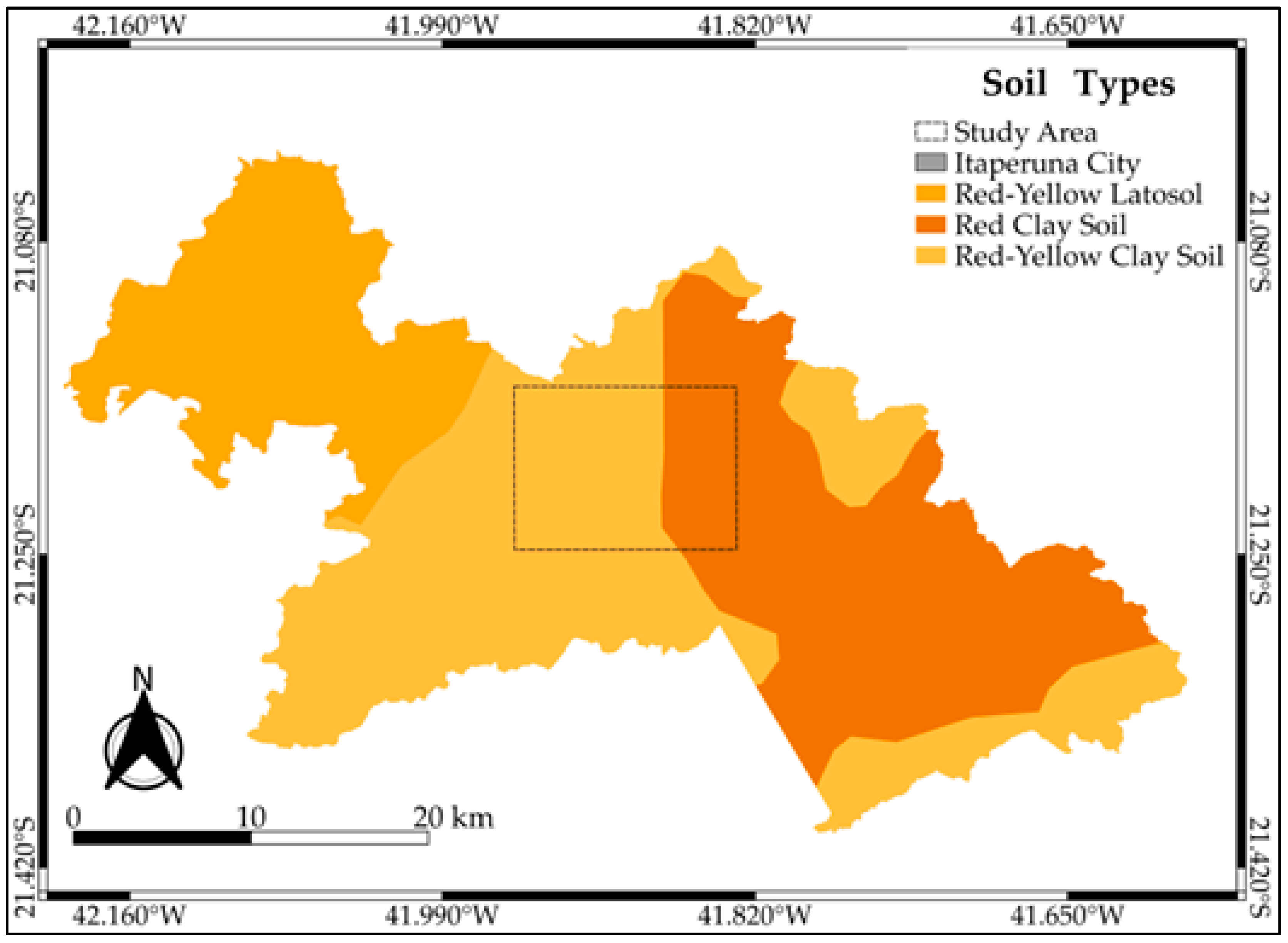
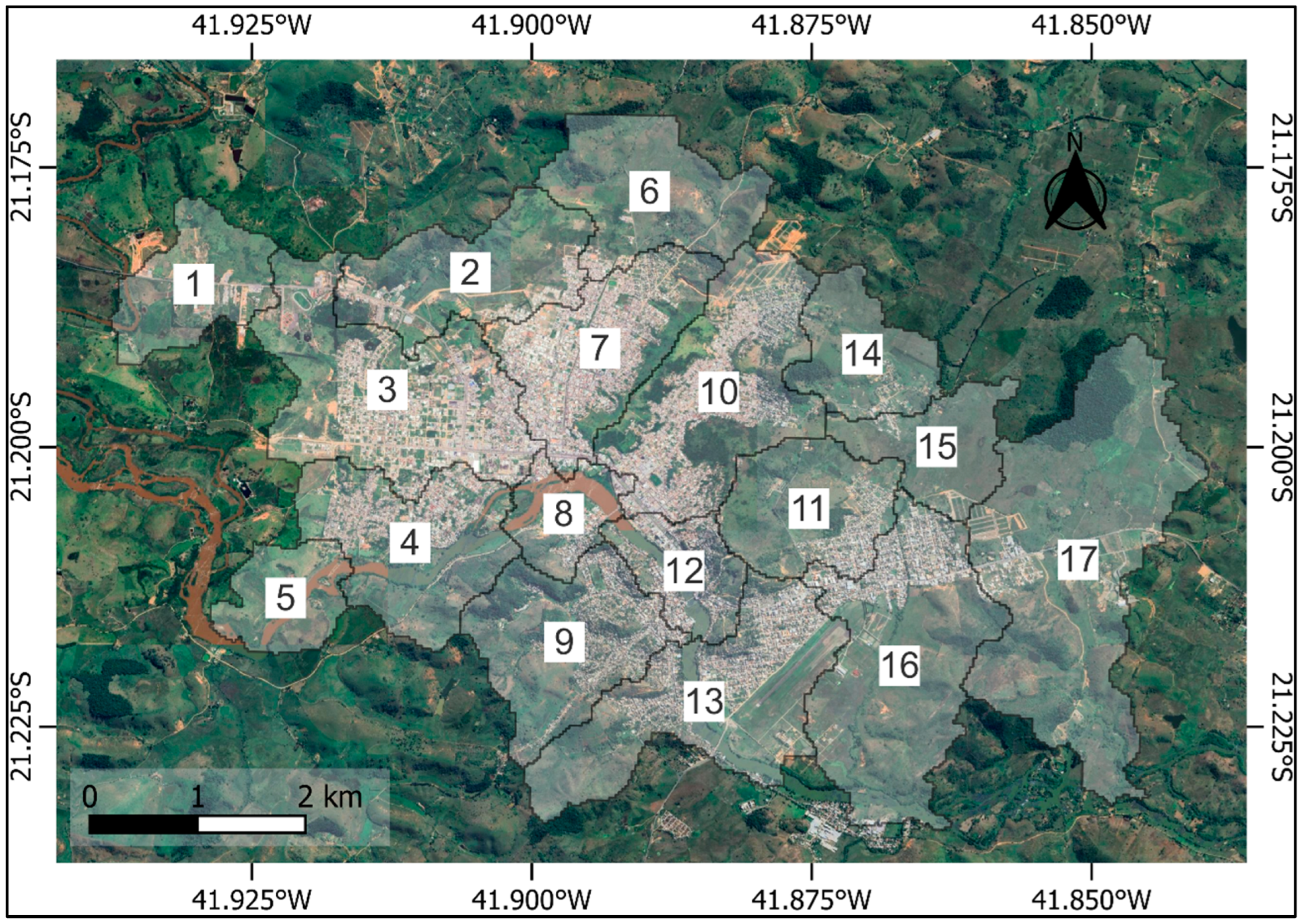
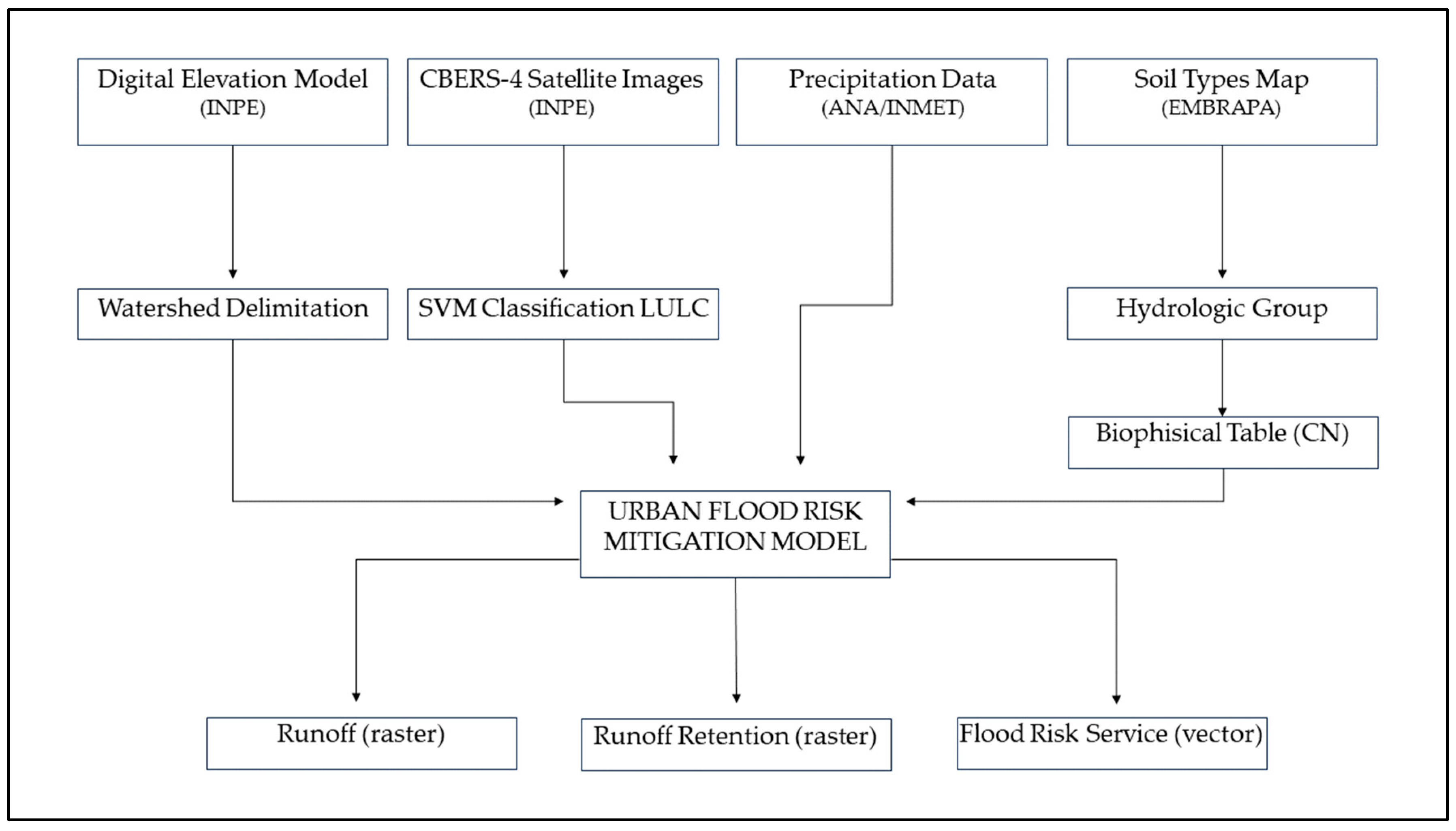
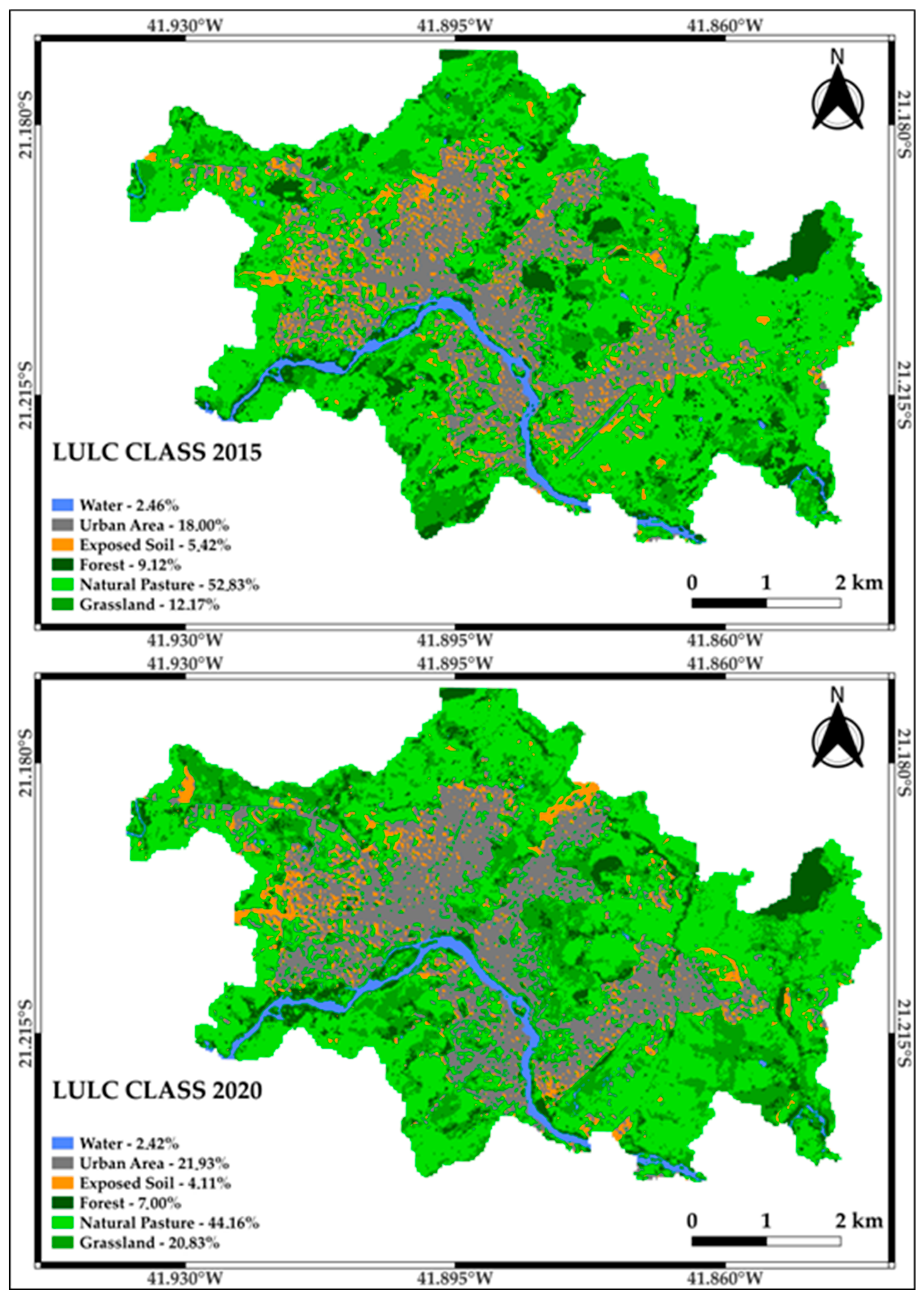

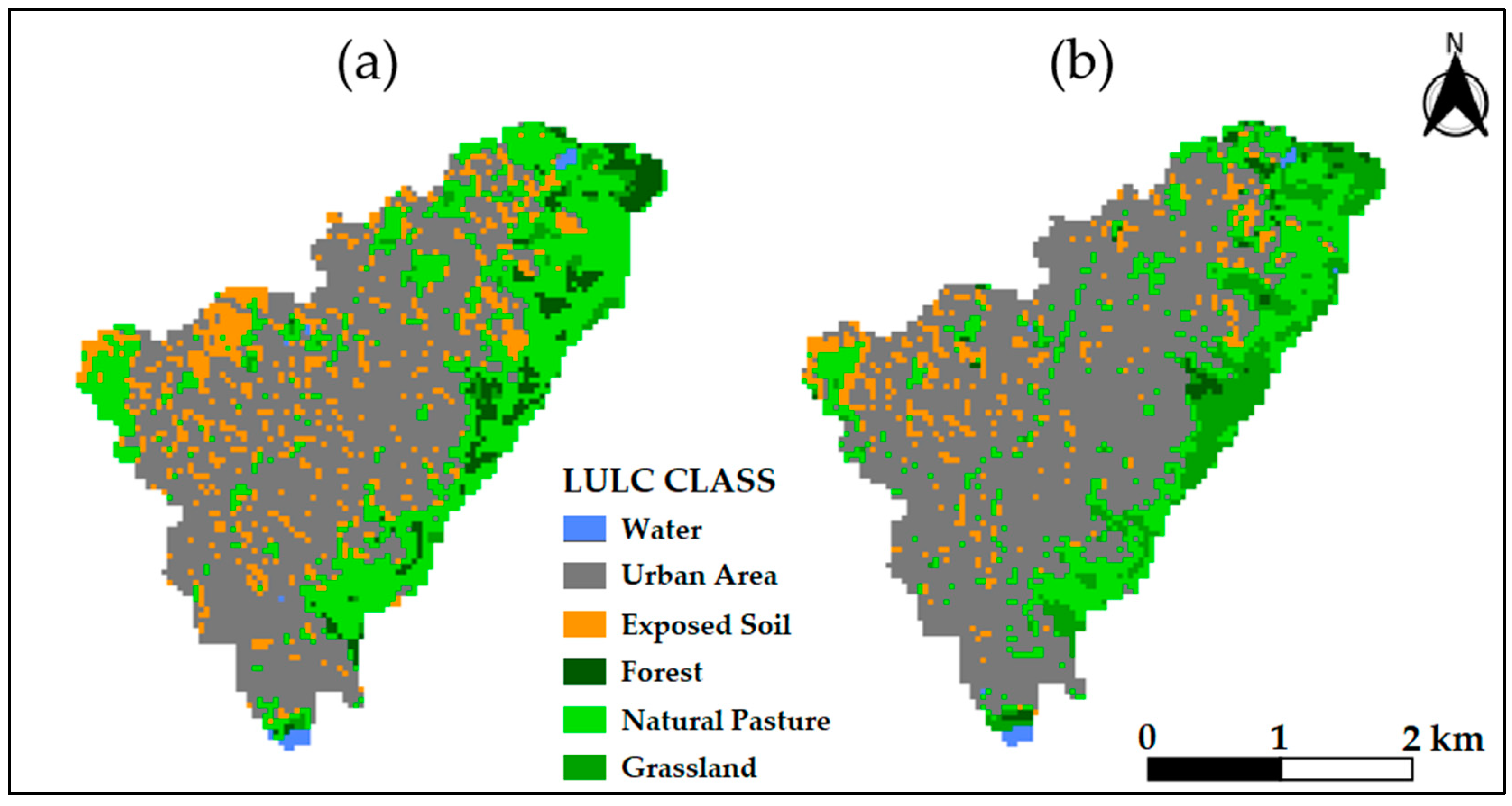
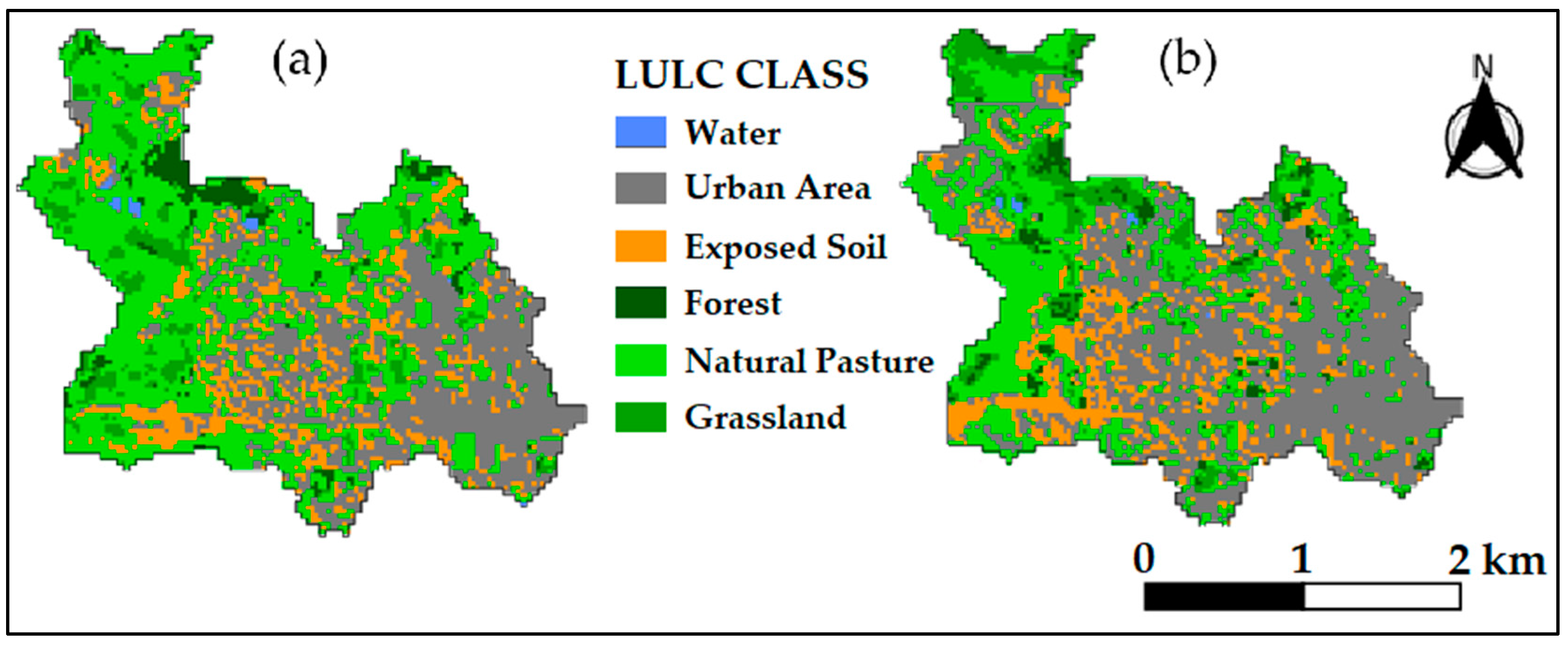
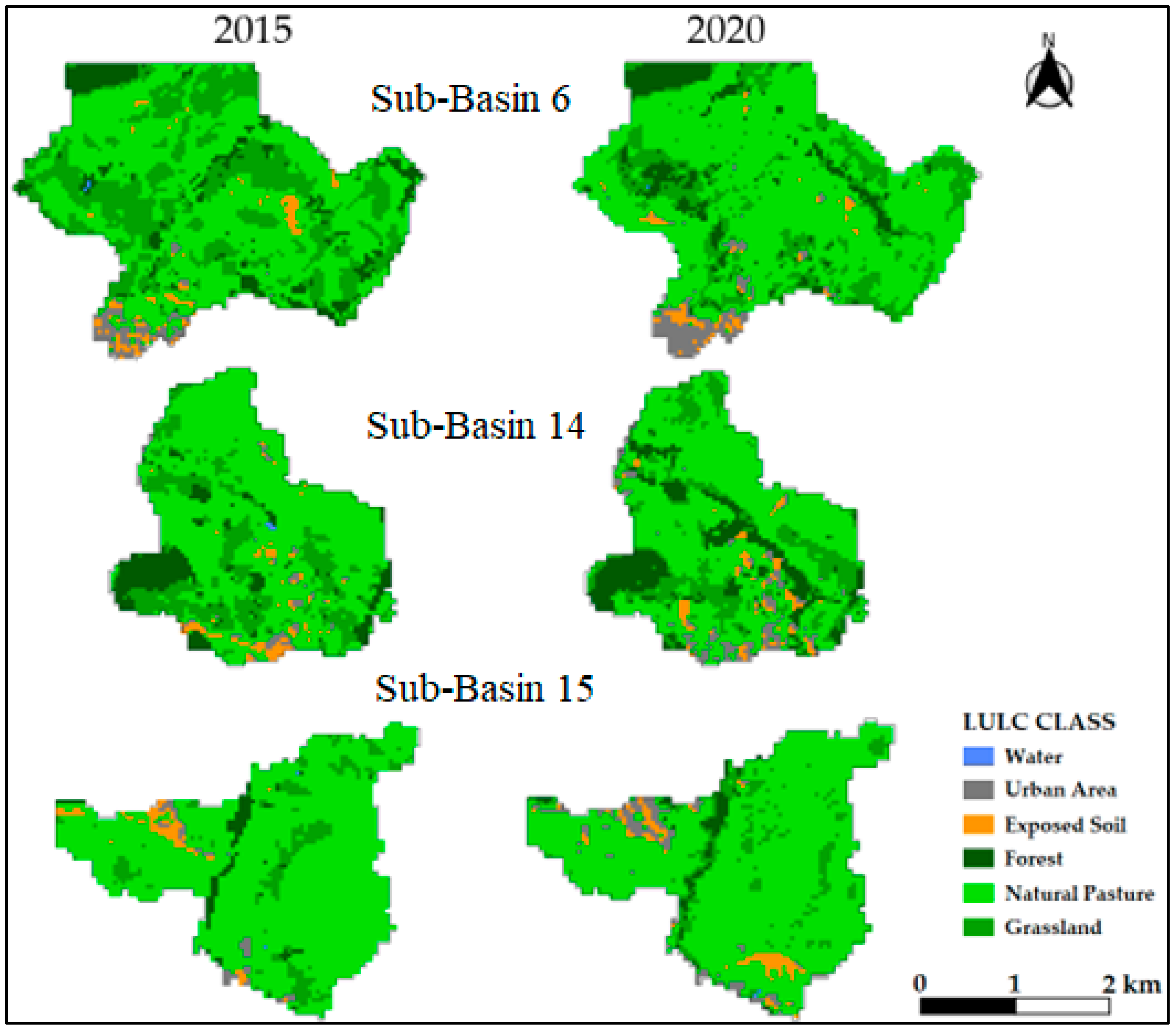
| LULC Class | LULC Code | ||||
|---|---|---|---|---|---|
| Water | 1 | 100 | 100 | 100 | 100 |
| Urban Area | 2 | 93 | 93 | 93 | 93 |
| Exposed Soil | 3 | 74 | 84 | 90 | 92 |
| Forest | 4 | 36 | 60 | 70 | 76 |
| Natural Pasture | 5 | 36 | 60 | 73 | 79 |
| Grassland | 6 | 30 | 58 | 71 | 78 |
| LULC Class | Water | Urban Area | Exposed Soil | Forest | Natural Pasture | Grass- Land | Overall Accuracy | Kappa Coeffi-cient | |
|---|---|---|---|---|---|---|---|---|---|
| 2015 | User Accuracy | 100.00% | 98.63% | 97.27% | 94.67% | 97.34% | 96.47% | 96.93% | 95.67% |
| Producer Accuracy | 100.00% | 93.75% | 96.35% | 96.32% | 96.85% | 95.48% | |||
| 2020 | User Accuracy | 100.00% | 97.36% | 98.26% | 98.35% | 98.52% | 96.64% | 97.64% | 96.37% |
| Producer Accuracy | 100.00% | 94.64% | 96.42% | 97.63% | 97.93% | 95.93% | |||
| Sub- Basin | Water | Urban Area | Exposed Soil | Forest | Natural Pasture | Grassland | ||||||
|---|---|---|---|---|---|---|---|---|---|---|---|---|
| 2015 | 2020 | 2015 | 2020 | 2015 | 2020 | 2015 | 2020 | 2015 | 2020 | 2015 | 2020 | |
| 1 | 1.68 | 1.84 | 9.96 | 14 | 7.48 | 8.68 | 7.84 | 10.8 | 96.16 | 77.72 | 29.04 | 38.88 |
| 2 | 0.32 | 0.12 | 22.4 | 33.72 | 11.12 | 7.28 | 17.4 | 14.04 | 132.12 | 118 | 37.2 | 48.68 |
| 3 | 1.52 | 0.96 | 117.12 | 163.16 | 49.56 | 49.32 | 14.48 | 12.24 | 159.64 | 108.76 | 22.56 | 30.12 |
| 4 | 16.24 | 15.8 | 47.6 | 60.32 | 13.84 | 8.92 | 27.08 | 23.64 | 113.6 | 100.2 | 30.44 | 39.64 |
| 5 | 11.04 | 12.4 | 0.24 | 2.56 | 0.52 | 1.16 | 11.84 | 10.28 | 71.68 | 65.36 | 12.6 | 16.2 |
| 6 | 0.12 | 0.04 | 6.08 | 10.04 | 5.36 | 3.84 | 18.56 | 19.52 | 119.64 | 144.48 | 68.12 | 40.04 |
| 7 | 1.36 | 1.12 | 131.16 | 153.64 | 30.72 | 16.8 | 10.68 | 3.52 | 63.96 | 44.4 | 4.84 | 23.24 |
| 8 | 18.16 | 17.44 | 22 | 24.8 | 6 | 4.52 | 6.84 | 6.12 | 29.92 | 22.56 | 8.6 | 16.12 |
| 9 | 0.2 | 0.2 | 54.12 | 60.64 | 12.36 | 4.84 | 25.36 | 16.2 | 124.48 | 110.56 | 26 | 49.68 |
| 10 | 0.12 | 0.2 | 125.48 | 137.12 | 19.12 | 22.4 | 37.8 | 12.88 | 119.64 | 85.64 | 23.2 | 66.4 |
| 11 | 0.68 | 0.44 | 25.92 | 37.72 | 7.8 | 4.12 | 14.08 | 13.36 | 98.2 | 85.92 | 35.52 | 41.44 |
| 12 | 16.72 | 16.2 | 44.08 | 43.84 | 6.08 | 2.56 | 7.48 | 2.24 | 32.72 | 26.08 | 1.24 | 17.72 |
| 13 | 17.8 | 18.68 | 75 | 91.6 | 22.76 | 13.36 | 23.36 | 15.12 | 136.96 | 134 | 53.32 | 55.68 |
| 14 | 0.16 | 0 | 3 | 7.44 | 3.84 | 4.04 | 14.6 | 21.24 | 91.44 | 82.2 | 26.88 | 24.64 |
| 15 | 0.08 | 0.08 | 2.64 | 6.16 | 3.04 | 3.92 | 4.2 | 3.56 | 107.72 | 103.48 | 11.08 | 10.8 |
| 16 | 8.84 | 8.24 | 68 | 81.48 | 17.92 | 10.96 | 31.88 | 7.32 | 213.48 | 202.28 | 36.68 | 66.16 |
| 17 | 5.52 | 4.36 | 15.08 | 27.56 | 9.52 | 15.08 | 95.32 | 73.96 | 355.8 | 292.44 | 69.84 | 137.12 |
| Average | 5.92 | 5.77 | 45.29 | 56.22 | 13.36 | 10.69 | 21.69 | 15.65 | 121.60 | 106.12 | 29.24 | 42.50 |
| Total | 100.56 | 98.12 | 769.88 | 955.8 | 227.04 | 181.8 | 368.8 | 266.04 | 2067.16 | 1804.08 | 497.16 | 722.56 |
| 2.49% | 2.44% | 19.10% | 23.73% | 5.63% | 4.51% | 9.15% | 6.60% | 51.29% | 44.78% | 12.33% | 17.94% | |
| Sub-Basin | Generated Runoff (m3/ha) | Variation | ||
|---|---|---|---|---|
| 2015 | 2020 | m3/ha | Percentage | |
| 1 | 643.09 | 657.27 | 14.18 | 2.21% |
| 2 | 650.19 | 669.53 | 19.34 | 2.97% |
| 3 | 802.45 | 862.03 | 59.58 | 7.42% |
| 4 | 740.49 | 754.89 | 14.41 | 1.95% |
| 5 | 651.83 | 673.01 | 21.18 | 3.25% |
| 6 | 593.50 | 603.53 | 10.03 | 1.69% |
| 7 | 907.76 | 927.30 | 19.53 | 2.15% |
| 8 | 862.08 | 861.04 | −1.04 | −0.12% |
| 9 | 710.99 | 708.56 | −2.43 | −0.34% |
| 10 | 794.11 | 814.83 | 20.72 | 2.61% |
| 11 | 668.00 | 691.90 | 23.90 | 3.58% |
| 12 | 911.20 | 892.29 | −18.91 | −2.08% |
| 13 | 759.23 | 774.09 | 14.86 | 1.96% |
| 14 | 598.14 | 609.91 | 11.77 | 1.97% |
| 15 | 604.72 | 618.16 | 13.44 | 2.22% |
| 16 | 706.93 | 716.24 | 9.31 | 1.32% |
| 17 | 602.40 | 613.02 | 10.62 | 1.76% |
| Average | 718.06 | 732.21 | 14.15 | 2.03% |
Disclaimer/Publisher’s Note: The statements, opinions and data contained in all publications are solely those of the individual author(s) and contributor(s) and not of MDPI and/or the editor(s). MDPI and/or the editor(s) disclaim responsibility for any injury to people or property resulting from any ideas, methods, instructions or products referred to in the content. |
© 2023 by the authors. Licensee MDPI, Basel, Switzerland. This article is an open access article distributed under the terms and conditions of the Creative Commons Attribution (CC BY) license (https://creativecommons.org/licenses/by/4.0/).
Share and Cite
da Silva, G.C.G.; Campos, P.C.d.O.; Reis, M.d.M.; Paz, I. Spatiotemporal Land Use and Land Cover Changes and Associated Runoff Impact in Itaperuna, Brazil. Sustainability 2024, 16, 325. https://doi.org/10.3390/su16010325
da Silva GCG, Campos PCdO, Reis MdM, Paz I. Spatiotemporal Land Use and Land Cover Changes and Associated Runoff Impact in Itaperuna, Brazil. Sustainability. 2024; 16(1):325. https://doi.org/10.3390/su16010325
Chicago/Turabian Styleda Silva, Gean Carlos Gonzaga, Priscila Celebrini de Oliveira Campos, Marcelo de Miranda Reis, and Igor Paz. 2024. "Spatiotemporal Land Use and Land Cover Changes and Associated Runoff Impact in Itaperuna, Brazil" Sustainability 16, no. 1: 325. https://doi.org/10.3390/su16010325
APA Styleda Silva, G. C. G., Campos, P. C. d. O., Reis, M. d. M., & Paz, I. (2024). Spatiotemporal Land Use and Land Cover Changes and Associated Runoff Impact in Itaperuna, Brazil. Sustainability, 16(1), 325. https://doi.org/10.3390/su16010325










